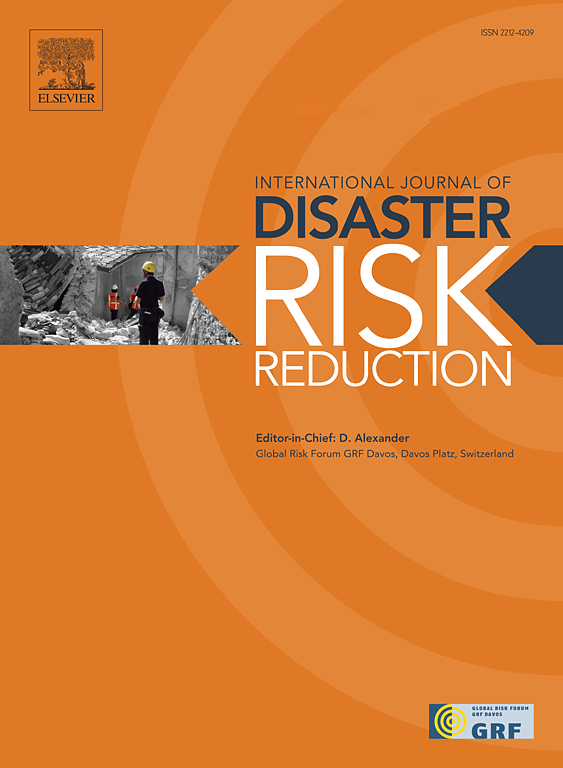可解释的GeoAI和统计分析揭示了关于2022年布法罗暴风雪期间311个帮助请求差异的互补见解
IF 4.2
1区 地球科学
Q1 GEOSCIENCES, MULTIDISCIPLINARY
International journal of disaster risk reduction
Pub Date : 2025-06-09
DOI:10.1016/j.ijdrr.2025.105635
引用次数: 0
摘要
2022年布法罗暴风雪是一场灾难性的冬季风暴,在2022年圣诞节的那一周袭击了纽约布法罗。这场地震造成47人死亡,并使该地区大部分地区在假日期间陷入困境。在这场灾难中,许多居民使用311电话服务来寻求帮助,因为暴风雪的问题。这项研究调查了这311个帮助请求及其在社区之间的潜在差异。具体而言,我们的目标是:(1)了解不同类型的311帮助请求的时空分布;(2)识别与311呼叫使用相关的物理和社会脆弱性因素以及人类行为因素。在方法上,我们利用可解释的地理空间人工智能(GeoAI)方法和统计分析来分析311个帮助请求及其相关因素。我们的分析显示,不同社区的311帮助请求存在显著的空间差异。可解释的GeoAI和统计分析的结果还揭示了与311帮助请求相关的关键因素的互补见解,例如历史311请求行为和少数民族人口的百分比。这些结果可以为未来的灾害管理决策提供信息,并有助于减轻冬季风暴灾害的负面影响。本文章由计算机程序翻译,如有差异,请以英文原文为准。
Explainable GeoAI and statistical analysis reveal complementary insights about disparities of 311 help requests during the 2022 Buffalo blizzard
The 2022 Buffalo blizzard was a catastrophic winter storm that struck Buffalo, New York in the week of Christmas in 2022. It claimed 47 lives and left much of the region stranded for the holiday week. In this disaster, the 311 call service was used by many residents to request help for issues due to the blizzard. This study examines these 311 help requests and their potential disparities across communities. Specifically, we aim to: (1) understand the spatial and temporal distributions of different types of 311 help requests; (2) identify the physical and social vulnerability factors, as well as human behavior factors, that are associated with the use of 311 calls. Methodologically, we leverage both explainable geospatial artificial intelligence (GeoAI) methods and statistical analysis to analyze 311 help requests and their associated factors. Our analysis shows significant spatial disparities in 311 help requests across communities. Results from explainable GeoAI and statistical analysis also reveal complementary insights on key factors associated with 311 help requests, such as historical 311 request behavior and percentage of minority population. These results could inform future disaster management decisions and help mitigate the negative impacts of winter storm disasters.
求助全文
通过发布文献求助,成功后即可免费获取论文全文。
去求助
来源期刊

International journal of disaster risk reduction
GEOSCIENCES, MULTIDISCIPLINARYMETEOROLOGY-METEOROLOGY & ATMOSPHERIC SCIENCES
CiteScore
8.70
自引率
18.00%
发文量
688
审稿时长
79 days
期刊介绍:
The International Journal of Disaster Risk Reduction (IJDRR) is the journal for researchers, policymakers and practitioners across diverse disciplines: earth sciences and their implications; environmental sciences; engineering; urban studies; geography; and the social sciences. IJDRR publishes fundamental and applied research, critical reviews, policy papers and case studies with a particular focus on multi-disciplinary research that aims to reduce the impact of natural, technological, social and intentional disasters. IJDRR stimulates exchange of ideas and knowledge transfer on disaster research, mitigation, adaptation, prevention and risk reduction at all geographical scales: local, national and international.
Key topics:-
-multifaceted disaster and cascading disasters
-the development of disaster risk reduction strategies and techniques
-discussion and development of effective warning and educational systems for risk management at all levels
-disasters associated with climate change
-vulnerability analysis and vulnerability trends
-emerging risks
-resilience against disasters.
The journal particularly encourages papers that approach risk from a multi-disciplinary perspective.
 求助内容:
求助内容: 应助结果提醒方式:
应助结果提醒方式:


